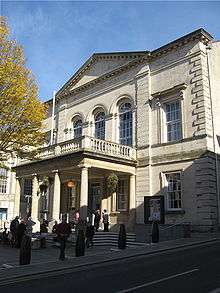Stroud
Stroud is a market town and civil parish in the centre of Gloucestershire, England. It is the main town in Stroud District.
| Stroud | |
|---|---|
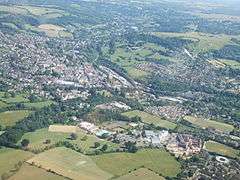 Stroud from the air | |
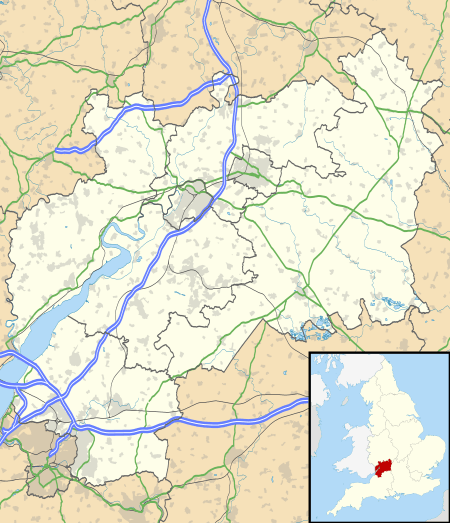 Stroud Location within Gloucestershire | |
| Population | 32,670 (2011)[1] |
| OS grid reference | SO851051 |
| Civil parish |
|
| District |
|
| Shire county | |
| Region | |
| Country | England |
| Sovereign state | United Kingdom |
| Post town | STROUD |
| Postcode district | GL5 |
| Dialling code | 01453 |
| Police | Gloucestershire |
| Fire | Gloucestershire |
| Ambulance | South Western |
| UK Parliament | |
| Stroud | ||||||||||||||||||||||||||||||||||||||||||||||||||||||||||||
|---|---|---|---|---|---|---|---|---|---|---|---|---|---|---|---|---|---|---|---|---|---|---|---|---|---|---|---|---|---|---|---|---|---|---|---|---|---|---|---|---|---|---|---|---|---|---|---|---|---|---|---|---|---|---|---|---|---|---|---|---|
| Climate chart (explanation) | ||||||||||||||||||||||||||||||||||||||||||||||||||||||||||||
| ||||||||||||||||||||||||||||||||||||||||||||||||||||||||||||
| ||||||||||||||||||||||||||||||||||||||||||||||||||||||||||||
Situated below the western escarpment of the Cotswold Hills at the meeting point of the Five Valleys, the town is noted for its steep streets, independent spirit and cafe culture.[2] The Cotswold Area of Outstanding Natural Beauty surrounds the town, and the Cotswold Way path passes by it to the west. It lies 10 miles (16 km) south of the city of Gloucester, 14 miles (23 km) south-southwest of Cheltenham, 13 miles (21 km) west-northwest of Cirencester and 26 miles (42 km) northeast of the city of Bristol. London is 91 miles (146 km) east-southeast of Stroud and the Welsh border at Whitebrook, Monmouthshire, lies 19 miles (31 km) to the west as the crow flies. Although not part of the town's parish, the civil parishes of Rodborough and Cainscross are contiguous with Stroud and are generally considered as suburbs.
Stroud acts as a centre for surrounding villages and small market towns including Amberley, Bisley, Bussage, Chalford, Dursley, Eastcombe, Eastington, King's Stanley, Leonard Stanley, Minchinhampton, Nailsworth, Oakridge, Painswick, Randwick, Selsley, Sheepscombe, Slad, Stonehouse, Brimscombe & Thrupp and Woodchester.
History
Stroud is known for its involvement in the Industrial Revolution.[3] It was a cloth town: woollen mills were powered by the small rivers which flow through the five valleys, and supplied from Cotswold sheep which grazed on the hills above. Particularly noteworthy was the production of military uniforms in the colour Stroudwater Scarlet.[4][5] Stroud became known for its production of broadcloth, which was widely known as "Stroud cloth" and traded around the world.[6] The area became home to a sizable Huguenot community in the 17th century, fleeing persecution in Catholic France,[7] followed by a significant Jewish presence in the 19th century, linked to the tailoring and cloth industries.[8]
Stroud was an industrial and trading location in the 19th century, and so needed transport links. It first had a canal network in the form of the Stroudwater Navigation and the Thames & Severn Canal, both of which survived until the early 20th century. Restoration of these canals as a leisure facility by a partnership of Stroud District Council and the Cotswold Canals Trust is well under way[9] with a multimillion-pound Lottery grant. Stroud railway station (on the Gloucester–Swindon Golden Valley Line) was designed by Isambard Kingdom Brunel.[10]
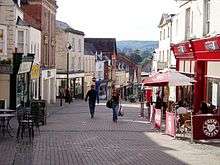
Though there is much evidence of early historic settlement and transport, Stroud parish was originally part of Bisley, and only began to emerge as a distinct unit in the 13th century, taking its name from the marshy ground at the confluence of the Slad Brook and the River Frome called "La Strode", and was first recorded in 1221. The church was built by 1279, and it was assigned parochial rights by the rectors of Bisley in 1304, often cited as the date of Stroud's foundation.[11]
Historic buildings and places of interest in the area include the neolithic long barrows at Uley, Selsley Common and Nympsfield to the west; Roman era remains at Frocester, West Hill near Uley, and Woodchester; the medieval buildings at Beverston Castle; and the outstanding Tudor houses at Newark Park and Owlpen Manor. Woodchester Mansion is a masterpiece of the Gothic Revival by local architect Benjamin Bucknall.[12]
From 1837 to 1841, Stroud's MP was Lord John Russell of the Whig party, who later became Prime Minister. Russell was an important politician: he was responsible for passing Acts of Parliament such as the Public Health Act 1848, but he is mainly remembered as one of the chief architects of the Reform Act 1867.[13] This Act, also known as the Second Reform Act, gave the vote to every urban male householder, not just those of considerable means. This increased the electorate by 1.5 million voters. Lord John Russell is remembered in the town in the names of two streets, John Street and Russell Street, as well as the Lord John public house. In 1835 the local press referred to Lord John Russell's opportunism in choosing Stroud as his new constituency as 'trying his hand in the vales of Gotham'. A reference to a 1798 Poem mocking Stroud residents for opening a church organ "before it could speak".[14] "Gotham" was a popular local town nickname and "house" name at Eastcombe Manor school in the 40/50s.
Neolithic remains
The long barrow at Randwick is large: about 56 by 26 metres (184 by 85 ft), it still stands 4 metres (13 ft) high at the north-east end. Excavations in 1883 found a round barrow opening to the north-east, from which there was access to a simple square chamber of one cell containing disarticulated human remains. Traces of the chamber can still be seen, although it is not accessible. Additional burials were found adjacent to the barrow on the south-west side.[15]
According to history books, the Iron Age tribesmen of Gloucestershire made their final stand against the massive Roman invasion on Minchinhampton Common. Survivors eventually fled to the north. Some earthworks, known as 'the Bulwarks,' and the Longstone of Minchinhampton are evidence of these ancient fortifications.[16]
Roman remains
Woodchester Roman Villa is one of many Roman villas discovered in Gloucestershire and was occupied between the early 2nd and late 4th centuries AD. There is now nothing visible of the villa above ground and the site is occupied by a later churchyard. The villa's most famous feature is the Orpheus mosaic, the second largest of its kind in Europe and one of the most intricate. It dates to c. AD 325 and was re-discovered by Gloucestershire-born antiquarian Samuel Lysons in 1793. It has been uncovered seven times since 1880, the last time in 1973, but there are no plans to reveal it again. It depicts Orpheus charming all forms of life with his lyre and has been praised for its accuracy and beauty.[17][18]
In 1979, several portions of Roman tessellated pavement, Roman tiles, coins, pottery, etc. were discovered in the grounds of the house at Brown's Hill, one mile north of Stroud, suggesting the existence of a Roman villa.
Remains of a Roman villa have been found in the parish of Painswick, on a farm called Highfield, about half a mile north-west of the town. Walls were found, crossing one another at right angles; also many flue tiles, and some Roman coins.[19] It was opened some years ago in a rough and hurried way, and covered up again. A short account of it appeared in the public press at the time.
The excavation at a site at Ebley Road in Stonehouse has revealed evidence of some of the earliest Roman activity known in the Stroud Valleys. A large rectangular enclosure dating back to the 1st century AD was found and more than a dozen human skeletons were unearthed at the end of 2010.[20]
Demography
At the 2001 UK census, Stroud civil parish had a total population of 12,690.[21] For every 100 females, there were 96.4 males. Ethnically, the population is predominantly white (98.2%).[22] 20.6% of the population were under the age of 16 and 8.3% were aged 75 and over; the mean age of the people of the urban area was 39.5. 92.6% of residents described their health as "fair" or better, similar to the average of 92.8% for the wider district.[23][24] The average household size was 2.4.[25] Of those aged 16–74, 24.5% had no academic qualifications,[26] lower than the national average of 28.9%. Of those aged 16–74, 2.6% were unemployed and 28.4% were economically inactive.[27] At the 2011 census, 107,026 people were described as white British, plus 591 being from the Irish Republic. 2,752 were white other, 364 Caribbean, 129 African, 429 Asian and 300 other Asian, all from mixed multiple ethnic groups. Of these, India, Pakistan and Bangladesh accounted for 258 people. Chinese and Arab people accounted for 226 people.
There are two definitions for the town of Stroud.[28] The narrowest definition is the parish, which had a population of 13,259 in 2011 and only includes the town centre and inner suburban areas.[29] The urban subdivision had a population of 32,670 and includes many suburbs often considered part of the town.[1] The urban area, which includes Stonehouse that has a largely separate identity, and other surrounding villages had a population of 60,155.[30] Despite its extensive urban area, Stroud is surrounded by the greenbelt of the Cotswolds to the north, south and east.
Character and amenities
Stroud has a significant artistic community that dates back to the early 20th century. Jasper Conran called Stroud "the Covent Garden of the Cotswolds";[31] the Daily Telegraph has referred to it as "the artistic equivalent of bookish Hay-on-Wye";[32] while the London Evening Standard likened the town to "Notting Hill with wellies".[33] The town has a large and diverse number of creative artists, musicians.[34]
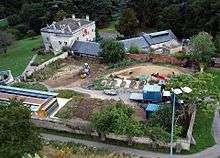
The town was one of the birthplaces of the organic food movement and was home to Britain's first fully organic café, Woodruffs.[35] The Biodynamic Agricultural Association is based in the town.[36]
For many years Stroud has hosted a fringe festival on the second weekend in September. A new committee took over in early 2015 and now holds the festival on August Bank Holiday each year. The festival has been expanded to cover art and literature, as well as a diverse range of unsigned bands who are a contract with a record label. With a number of outdoor stages, and the majority of the venues in town taking part, over 400 performers can be seen free of charge over the course of the weekend. The town also hosts an annual series of lectures and exhibitions on contemporary textiles and textile culture called SELECT, run by Stroud International Textiles,[37] the UK's only festival to celebrate the diverse culture of textiles.[38]
The Stroudwater Textile Trust was founded in 1999 to link the past and present of textiles in the Five Valleys[39] and to manage the opening of several mills in which historic textile machinery, including a working waterwheel, has been restored and is demonstrated. The Trust has produced a DVD, Rivers of Cloth, using archive film and interviews which was due to be released in early 2011 and a photographic survey of surviving woollen mills was undertaken for a book, Wool and Water, published in 2012.[40]
Stroud has a strong community of independent shops and cafés. The town centre has seen two controversial developments: a new cinema (which replaced the bus station) and a branch of McDonald's which, when plans were unveiled in 2004, came against opposition from locals.
The Subscription Rooms in the heart of the town centre provide a venue for a wide variety of entertainment[41]. There is also a small theatre, the Cotswold Playhouse, which is home to the amateur Cotswold Players; it occasionally hosts visiting professional companies.[42]
On the fringes of the town are Stratford Park, originally the park of a small local weaver, now home to a leisure centre with an indoor and an outdoor swimming pool, and the Museum in the Park, a museum of the history and culture of the Stroud valleys.
The Redlers industrial estate is the site of the original Dudbridge Mills, beside the River Frome. From the mid-18th century onwards it housed the three mills of Daniel Chance: one corn, one gig and a dyehouse with eight drying racks. It was acquired in 1794 by John Apperley, whose family used the site for wool- and cloth-making for the next 140 years. In 1801 an industrial accident killed a young worker.
Campaigns
Stroud citizens have a history of protest going back to the Stroudwater Riots of 1825.[43][44] In the late 1970s Stroud Campaign Against The Ringroad prevented Gloucestershire County Council's attempt to introduce new traffic plans. A few years later Stroud District Council tried to demolish 18th-century buildings in the town centre. Stroud High Street Action Group, with some rooftop protests and a high court judgement, demonstrated against this. The restored buildings are now a feature of the High Street. After a short occupation a compromise was reached in the demolition of buildings in Cornhill with many being saved, including one identified as a medieval house. This campaign led to the formation of the Stroud Preservation Trust. which has been instrumental in saving many of the town's oldest buildings such as Withey's house, the Brunel Goods Shed and the Hill Paul building.[45]
Stroud Save The Trees Campaign came to national prominence in August 1989 when Stroud District Council tried to implement a road-widening scheme by a midnight raid on thirteen trees it wished to fell within the perimeter of Stratford Park. However local people got wind of the 'secret' and were there first to protect the trees. After a stand-off that lasted till dawn the police called off the operation on the grounds of public safety. The following year instead of road-widening the first 'traffic calming' in the county was installed. The trees remain to this day.
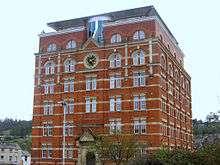
A few years later Stroud District Council planned to fell the hornbeam on the Subscription Rooms forecourt, the only mature tree in the town centre. A quickly mobilised citizenry persuaded them otherwise and the hornbeam survived.
In 2000 Stroud District Council gave permission for the Victorian landmark Hill Paul building to be demolished. After thwarting demolition, local activists formed a company and sold enough shares at £500 each to take an option on the building, which they passed on to a local developer. The building has now been restored and converted into apartments (see photo on the right).[46][47]
The Save Stroud Hospitals Taskforce has been campaigning since spring 2006 against a range of cuts to health services in and around Stroud, with thousands of people taking part in street demonstrations. Stroud Maternity Hospital was saved in September 2006.[48]
The Uplands Post Office branch in Stroud was one of 26 in the county to shut as part of a nationwide programme to cut losses. Following local opposition, the Post Office agreed to talks with civic chiefs to look at how it could reopen. The town council agreed to provide £10,000 of funding for the service in 2008 and up to £25,000 for 2009. In November 2008 it was confirmed that Stroud has become only the second place in Britain to save one of its Post Offices.[49]
However, despite the protests, Tesco opened a store near Stratford Park in 1989, McDonald's built a fast food restaurant at Rowcroft in 2005 and, soon after, the bus station was replaced with a cinema.
In September 2010 the BNP scrapped plans to move their national media centre to Stroud after protests by local residents.[50]
In February 2012 NHS managers agreed to halt plans for Stroud General Hospital to be run by a social enterprise after local residents mounted a legal challenge in the High Court.[51]
Business
There is still a small textile industry (the green baize cloth used to cover snooker tables and the cloth covering championship tennis balls is made here), but today the town functions primarily as a centre for light engineering and small-scale manufacturing, and a provider of services for the surrounding villages. Stroud is a Fairtrade Town.
The Stroud and Swindon Building Society had its headquarters here until it merged with the Coventry Building Society on 1 September 2010. The building is now the headquarters of the renewable energy provider Ecotricity.[52]
Damien Hirst owns the 'Science' facility in Stroud which produces his art.[53]
In September 2009, the Stroud Pound Co-operative launched the Stroud Pound[54] as an attempt to reinforce the local economy and encourage more local production. The currency's design follows that of the Chiemgauer, in being backed on a one-for-one basis by the national currency, having a charge for redemption which is donated to local charities, and including a system of demurrage to encourage rapid circulation.
Farmers' market
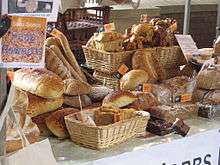
A farmers' market, launched by Jasper Conran and Isabella Blow on 3 July 1999,[55] takes place every Saturday at the Cornhill market. It was nominated for the national Farmers' Market of the Year in 2001 and won it in 2007 and 2013. It also won the Cotswold Life magazine award for the best farmers' market in Gloucestershire in 2003, 2004, 2005 and 2010. The market featured in an episode of BBC TV's The Hairy Bikers' Food Tour of Britain in September 2009, and won the Best Food Market award at the BBC Food & Farming Awards 2010.[56] It is certified by FARMA.
In addition to the farmers' market there is a smaller market held (Fri & Sat) in The Shambles, an area adjacent to the steep High Street. John Wesley preached from a butcher's block in The Shambles on 26 June 1742.[57] opposite one of the oldest existing buildings in Stroud, the Old Town Hall. Originally called the Market-house, this was built in 1594[58] and is still in occasional use today. Hinged trestles can still be seen along the Shambles, with cut marks, previously used by butchers probably from before WW2.
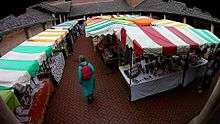
Education
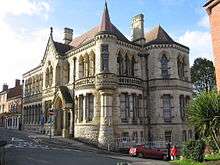
History
"There was a school at Stroud in 1576 but the schoolmaster, who did not have a licence and failed to teach the catechism, was then dismissed..."[59]
Primary schools
There are six primary schools in the town:
- Uplands Community Primary School[60]
- Callowell Primary School[61]
- Gastrells Community Primary School[62]
- Rosary Catholic Primary School[63]
- Severn View Academy[64]
- Stroud Valley Community School[65]
Schools in surrounding areas include
- Rodborough Community Primary school
- St Matthew's School (Cainscross)[66]
- Cashes Green Primary school (Cainscross)
- Foxmoor Primary School (Cainscross)
- Whiteshill Community Primary school
- Randwick CE Primary school
- Gastrells Community Primary school[67]
Further schools include Amberley Parochial School, Nailsworth School and Woodchester School.
Secondary schools
There are three secondary schools in Stroud.
Archway School[68] is a County Council maintained comprehensive school offering an 11-to-18 education for children in Stroud, Rodborough and Cainscross.
There are also two state-funded selective schools, Marling School and Stroud High School. These former grant-maintained and foundation schools became academies in 2011. Both schools can trace their history back to the founding of Marling School in 1889 and Stroud High School which was founded in 1904 as the Girls' Endowed School. They continued to be grammar schools long after the comprehensive school became the norm in secondary education, and their future was the subject of long-running controversy.[69] The two schools now share a mixed sixth form, called the Downfield Sixth Form, which works in a three-way consortium with Archway Sixth Form and South Gloucestershire and Stroud College and attracts pupils from many surrounding schools.
Other secondary schools in the locality include Maidenhill School in Stonehouse, and Thomas Keble School in Eastcombe and the private Wycliffe College in Stonehouse
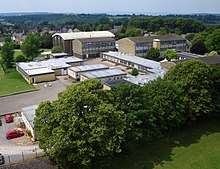
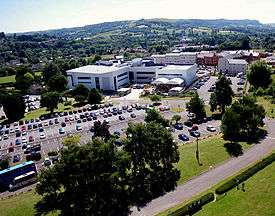
Tertiary education
Tertiary education in the town is provided by South Gloucestershire and Stroud College.
The University of Gloucestershire has campuses a few miles to the north (in Cheltenham and Gloucester) and the Royal Agricultural University west of Cirencester is 12 miles (19 km) to the east.
Transport
Public bus transport in Stroud is run by Stagecoach West, operating from its depot on London Road, and Cotswold Green. Some of these routes deployed from Stroud are Stagecoach Gold, including the 63 to Gloucester and the 66S/E/Q/Y.
The town is also served by Great Western Railway trains from Stroud railway station, with frequent services to Gloucester, Cheltenham, Swindon, Reading and London Paddington. The railway link was established in 1845. Up to then, Stroud had its own time which was set by a sundial at the top of Gloucester Street. There was also an observatory across the road from the hospital where now is a car park. As Stroud time was roughly 9 minutes behind GMT and people kept missing the train, a railway clock was put up in 1858 at the bottom of High Street. It was later moved across King Street to the top of Gloucester Street. The clock fell into disrepair over the years. It was finally saved by Captain Michael Maltin, who restored the clock in 1984 and found a new home for it in the Stroud library. Stonehouse railway station is on the western edge of the town and in the wider urban area.
The A46 road links Stroud to Cheltenham in the north and Bath to the south, with the A419 connecting Stroud to Cirencester in one direction and the M5 motorway at Junction 13 in the other.
National Express coaches serve the town on routes 401 (Bristol – London Victoria) and 445 (Hereford – London Victoria). Stroud also lies on the traffic-free section of Sustrans National Cycle Network Route 45.
Stroud was connected to the canal system when the Stroudwater Navigation opened in 1779. It then became part of a through canal route from Bristol to London when the Thames and Severn Canal added a route over the Cotswolds in 1789. The canal closed in 1954 but the Cotswold Canals Trust is leading a project to reopen the entire length of the trans-Cotswold route. A visitor centre and restored lock are located in the town.
Literature
Novelists Sue Limb, Jilly Cooper and Katie Fforde, children's authors Jamila Gavin, John Dougherty Cindy Jefferies and Clive Dale, poet Jenny Joseph, and The Guardian's food critic Matthew Fort have followed in the footsteps of the Rev. W. Awdry, and W. H. Davies and made the Stroud area their home.
Two of its most famous sons are the authors Laurie Lee, whose most notable creation Cider with Rosie is set in the nearby Slad valley, and Booker Prize-winning author Alan Hollinghurst. Poets Dennis Gould, Jeff Cloves, Philip Rush, Ted Milton, Michael Horovitz, Frances Horovitz and Adam Horovitz have grown up, lived and/or live in the area.
Culture
Stroud is home to the Bardic Chair of Hawkwood, an annual competition held at Hawkwood College in May to select that year's Bard who then has the responsibility to promote the bardic arts in the Stroud area.
Sport
Stroud Rugby Club, founded in 1873, play in the Western Counties North league. Their home ground is Fromehall Park, near the town centre.
Stroud Cricket Club is over 150 years old and plays its home games at Farmhill. The club has three senior teams, with the first eleven playing its cricket in the South West Premier league.
Since 1982 Stroud Athletic Club has organised an annual half marathon which takes place in October. Nearly 2,500 runners, from all over the country, entered in 2007. Members of the club include the UK number one Olympic Marathon runner Dan Robinson.
Stroud Swimming Club was officially formed in 1978, but can trace its origins back to 1905 when it was known as Stroud Swimming and Water Polo Club. In 2006 and 2007 club members made up two-thirds of the County team that finished in silver and bronze places respectively in the National Open Water Championships.[70]
Stroud Hockey Club was founded in 1928 and has produced some top-class hockey players including Simon Mason. The club has three men's teams, three women's teams and a boys Badgers and a girls Vixens team, and under 8s, 10s and 12s for rising club stars. The club's home ground is at Stratford Park Leisure Centre, with training on Tuesday evenings during the season.
Forest Green Rovers is the nearest professional football club and play in EFL League Two. They play around 3.5 miles away in nearby Nailsworth. A lot of supporters live and come from Stroud.
Politics and media
Siobhan Baillie[71] is the current Member of Parliament (MP) for Stroud, having beaten the sitting Labour MP, David Drew, at the 2019 general election.[72] Drew had previously represented the constituency from 1997 until 2010, when Conservative Neil Carmichael was elected, and from 2017 to 2019.
In March 2008, a community radio station, Stroud FM, was launched in the town, broadcasting 24 hours a day on 107.9FM. The station, staffed by volunteers and funded by donations, focussed on local news and music, as well as national and international music, but closed in February 2014 due to a lack of funds. Both BBC Radio Gloucestershire and Heart (Gloucester) have dedicated FM and DAB transmitters serving the town.
There are now two local newspapers covering the town: the weekly Gloucester Citizen, now called Stroud Citizen to replace Stroud Life, published by Gloucestershire Media (part of the Northcliffe Group); and the Stroud News & Journal, published by Newsquest Media (Southern) Limited, part of the American Gannett Company.
Stroud Life launched in 2008 and closed in October 2017. Most of its distribution was free direct to homes, but a significant share (about one-third) was sold through the news trade.[73] The Stroud News and Journal was formed by a merger in 1959 of the Stroud Journal (which started in 1854 as a Liberal-supporting newspaper) and the Stroud News (which started in 1867 and generally supported Conservative and Unionist interests).
Crime
Figures from the local police force and the local Crime and Disorder Reduction Partnership indicate that Stroud has a significantly lower level of crime per head of population than the national average.[74]
| Offence | Locally | Nationally |
|---|---|---|
| Robbery | .31 | 1.85 |
| Theft of a motor vehicle | 2.39 | 4.04 |
| Theft from a motor vehicle | 7.11 | 9.59 |
| Sexual offences | .79 | 1.17 |
| Violence against a person | 13.36 | 19.97 |
| Burglary | 3.19 | 5.67 |
Notable people
Activists
- Polly Higgins, barrister, author, and environmental lobbyist lived near Stroud for the last few years of her life.[75][76]
Actors
- Arabella Holzbog, actress, born in Stroud
- Geoffrey Hutchings, actor, lived in Stroud[77]
- Tim McInnerny, actor (Blackadder), attended Marling School[78]
- Tamzin Malleson, actress, grew up in Chalford, attending Archway School, and now lives near Minchinhampton with partner Keith Allen
- William Moseley, actor, The Chronicles of Narnia
- Colin Prockter, actor, Doctor Who, co-wrote Luna, lives in Stroud
- Emma Samms, actress, lives in Stroud
- Sophie Ward, actress, lived in France Lynch[79]
Artists
- Leo Baxendale, creator of Minnie the Minx, lived nearby[80]
- Lynn Chadwick, sculptor[81]
- Damien Hirst, artist, has a studio in Chalford and another in Stroud[82]
- Tim Noble, artist[83]
- Jack Russell, former Gloucestershire and England cricketer, now artist, attended Archway School[84]
- Alan Thornhill, sculptor[85]
- Josh Record, singer/songwriter[86]
- Paul Hervey-Brookes plantsman and garden designer[87]
Authors
- Rev. W. Awdry, creator of Thomas the Tank Engine, moved to the area[88] and was the Reverend of the parish church of Rodborough until his death in 1997. He is fondly remembered in the area and was seen daily riding his bicycle up the steep Rodborough hill.
- Jilly Cooper, author, moved to the area
- Katie Fforde, author, moved to the area[89]
- Matthew Fort, food writer, critic, and Guardian food columnist[90]
- Jamila Gavin, children's author, moved to Stroud[91]
- Adrian Liddell Hart, author and adventurer
- Basil Liddell Hart, military theorist
- Alan Hollinghurst, author, born in Stroud[92]
- Frances Horovitz, poet and broadcaster, lived near Stroud, 1971–80
- Michael Horovitz, political poet and publisher, used to live in the area
- Jenny Joseph, poet, writer of "I Shall Wear Purple", lives in nearby Minchinhampton
- Laurie Lee, author, born in Stroud and grew up in the Slad Valley, the setting of Cider with Rosie
Engineering and manufacturing
- Edwin Beard Budding (1795–1846), inventor of the lawnmower and adjustable spanner, born and died in Stroud[93]
- Arnold Redler (1875–1958), founder of the conveying company Redler Limited in Stroud in 1920 and inventor of the en-masse conveyor[94]
Historians
- Peter Hennessy, historian of government, attended Marling School[95]
Musicians
- Milk Teeth, grunge rock band formed at South Gloucestershire and Stroud College
- Emily Barker, singer, songwriter, lives in Stroud[96][97]
- Geoffrey Burgon, composer[98]
- Eamon Hamilton, frontman of Brakes and former keyboard player of British Sea Power, raised in Stroud[99]
- Jamie Hornsmith, bass guitarist of The Rakes
- Pendragon, progressive rock band[100]
- Gerry Rafferty died in Stroud in January 2011, at the home of his daughter Martha
- Sade, singer, songwriter of the band Sade, moved to Slad, near Stroud in 2010[101]
- Tom Smith, lead singer of Editors, grew up in Stroud[102]
- Martha Tilston, folk singer and daughter of Steve Tilston, moved to the area
- Sarana VerLin, Detroit singer-songwriter, violinist, and organizer of Stroud Americana Festival, moved to Stroud[103]
Scientists
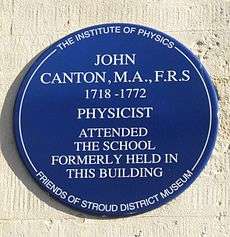
- John Canton (1718–1772), physicist[104]
- Sir Martin Evans, Nobel Prize in Physiology or Medicine, born in Stroud[105]
- Henry Miles (1698–1763), dissenting minister and writer on science, born and educated in Stroud
Sportsmen and women
- Dominic Dale, snooker player[106]
- Eddie "The Eagle" Edwards, ski jumper, lives in nearby Woodchester[107]
- Alastair Hignell, sportsman and commentator[108]
- Frank Keating, sports journalist at The Guardian[109]
- Stuart Nelson, footballer, Notts County[110]
- Emily Pidgeon, athlete[111]
- Dan Robinson, Olympic marathon runner
- Laurence Shahlaei, winner of Britain's Strongest Man
Others
- Sidney Cooke, child molester and serial killer, was born in Stroud.[112]
Twin towns



.svg.png)
Songs about Stroud
- "Stroud, The Town of Make Believe", on the album Kenny Rogers' Greatest Hit, by post-punk band Blurt, founded in Stroud in 1979.
References
- "Stroud (Gloucestershire, South West England, United Kingdom) - Population Statistics, Charts, Map, Location, Weather and Web Information". citypopulation.de. Archived from the original on 31 March 2018. Retrieved 31 March 2018.
- "More for lovers of cafe culture". Stroud News and Journal. 13 October 2004. Retrieved 19 July 2020.
- Archived 15 September 2017 at the Wayback Machine Hansard 17 June 1997 : Column 185. Retrieved 13 September 2009
- "History Of The Industrial Stroud Valleys" (PDF). Archived from the original (PDF) on 27 September 2012.
- British South West wool industries and manufactured tradecloths Archived 5 October 2011 at the Wayback Machine Wrapping The Globe
- Giles, Sue (2005). "Wrapping the World: British South West Trade Cloth Around the World". Journal of Museum Ethnography. 17: 256–258 – via JSTOR.
- The Huguenots – Their Settlements, Churches and Industries in England by Samuel Smiles
- The Jewish Community Of Stroud, 1877–1908 Archived 1 March 2007 at the Wayback Machine Jewish Community and Records UK, Harold Pollins 1996. Retrieved November 2006.
- "Cotswold Canals Trust". Archived from the original on 9 April 2010.
- "Brunel". Stroud District Council. Retrieved 19 July 2020.
- "St Laurence: The Future". St Laurence Parish Church, Stroud. Archived from the original on 11 January 2020. Retrieved 19 July 2020.
- "The Mansion". National Heritage List for England. Historic England. Archived from the original on 17 July 2020. Retrieved 19 July 2020.
- "Lord John Russell, 1st Earl Russell". Past Prime Ministers. Gov.uk. Archived from the original on 31 May 2020. Retrieved 19 July 2020.
- British Newspaer archive sesarching for: 1798 poem stroud gotham
- "Randwick Hill long barrow, round barrows and dyke". National Heritage List for England. Historic England. Archived from the original on 29 December 2019. Retrieved 19 July 2020.
- "Minchinhampton Pages 81-84 Ancient and Historical Monuments in the County of Gloucester Iron Age and Romano-British Monuments in the Gloucestershire Cotswolds". British History Online. Her Majesty's Stationery Office, London. Retrieved 19 July 2020.
- "Woodchester Roman villa". National Heritage List for England. Historic England. Retrieved 19 July 2020.
- "Woodchester Villa". Pastscape. Historic England. Retrieved 19 July 2020.
- "Painswick: Introduction Pages 56-65 A History of the County of Gloucester: Volume 11, Bisley and Longtree Hundreds". British History Online. Victoria County History,. Archived from the original on 30 May 2017. Retrieved 19 July 2020.CS1 maint: extra punctuation (link)
- "Archaeological dig uncovers Roman activity near Stroud". BBC. Retrieved 19 July 2020.
- "KS01: Usual residential population". Office for National Statistics. Archived from the original on 26 May 2011. Retrieved 6 October 2010.
- "KS06: Ethnic group". Office for National Statistics. Archived from the original on 4 August 2009. Retrieved 6 October 2010. At the 2011 census in the wider borough of Stroud, 107.026 people were white British, 591 Irish, 2.752 white other, 364 Caribbean, 129 African, 429 Asian and 300 other Asian, all from mixed multiple ethnic groups. Of these, 177 were Indian, 28 Pakistani, 53 Bangladeshi, and 193 Chinese, with 33 being of Arab origin.
- "KS08: Health and provision of unpaid care". Office for National Statistics. Archived from the original on 29 June 2011. Retrieved 6 October 2010.
- "KS16: Household spaces and accommodation type". Office for National Statistics. Archived from the original on 29 June 2011. Retrieved 6 October 2010.
- "KS13: Qualifications and students". Office for National Statistics. Archived from the original on 4 August 2009. Retrieved 6 October 2010.
- "KS09a: Economic activity". Office for National Statistics. Archived from the original on 5 August 2009. Retrieved 6 October 2010.
- "City Population - Site Search". citypopulation.de. Archived from the original on 31 March 2018. Retrieved 31 March 2018.
- "Stroud (Parish, United Kingdom) - Population Statistics, Charts, Map and Location". citypopulation.de. Archived from the original on 31 March 2018. Retrieved 31 March 2018.
- "United Kingdom: Urban Areas in England - Population Statistics, Maps, Charts, Weather and Web Information". citypopulation.de. Archived from the original on 31 March 2018. Retrieved 31 March 2018.
- "Stroud Town Centre". Archived from the original on 13 March 2016. Retrieved 8 March 2004.
- Made in Gloucestershire Archived 18 October 2015 at the Wayback Machine BBC Gloucestershire
- Lillywhite, Maisie (19 September 2019). "This is where Gloucestershire's Earth Strikes will take place". Gloucestershire Live. Archived from the original on 5 December 2019. Retrieved 19 July 2020.
- "Our Leading Artists". Discover Stroud District. Visit Cotswolds. Retrieved 19 July 2020.
- Wild in the Cotswolds Archived 13 February 2009 at the Wayback Machine
- Biodynamic Association and Demeter in the UK Archived 2 November 2008 at the Wayback Machine Biodynamic Agricultural Association
- "SITSelect". Archived from the original on 1 October 2017. Retrieved 28 September 2017.
- "International textile festival gives English town a boost". BBC News. 5 May 2011. Archived from the original on 26 November 2017. Retrieved 28 September 2017.
- "About Us". Stroudwater Textile Trust. 2013. Archived from the original on 28 September 2017. Retrieved 28 September 2017.
- Tann, Jennifer (2012). Wool & Water: The Gloucestershire Woollen Industry And Its Mills. The History Press. ISBN 0752462156.
- Council, Matt wilkins - Stroud District. "What's On - Entertainment and events in Stroud". subscriptionrooms.org.uk. Archived from the original on 24 March 2018. Retrieved 31 March 2018.
- "Home page". The Cotswold Playhouse. Archived from the original on 29 September 2017. Retrieved 28 September 2017.
- Stroudwater Riots of 1825 by John Loosley (Author), Ian Mackintosh (Author), Jane Ford (Illustrator) Publisher: Stroud Museum Association (1 Jun 1993) ISBN 0-9521149-0-9 ISBN 978-0-9521149-0-1
- The Cloth Industry in the West of England from 1640 to 1880 By Julia de Lacy Mann Published by Clarendon Press, 1971 ISBN 978-0-86299-447-1 ISBN 0-86299-447-0
- Walmsley, Peter (1994). Towns and villages of England – Stroud. Alan Sutton. ISBN 0-7509-0589-1.
- "Digital Stroud". Archived from the original on 1 April 2012.
- The Vernacular Architecture and Buildings of Stroud and Chalford By Nigel McCullagh Paterson Pub:Trafford Publishing, 2006 ISBN 1-4120-9951-X, ISBN 978-1-4120-9951-6. Archived from the original on 24 March 2017. Retrieved 13 October 2016.
- Final decision on Weavers Croft Archived 5 March 2016 at the Wayback Machine Save Stroud Hospitals
- Post office saved in town BBC News
- Tamash Lal. "JUST IN: BNP scraps plans for media office in Stroud following opposition". Stroud News and Journal. Archived from the original on 2 October 2010. Retrieved 29 September 2010.
- "Plans to move NHS services to social enterprise halted". The Guardian. 10 February 2012. Archived from the original on 11 January 2020. Retrieved 11 January 2020.
- "Ecotricity offices". ecotricity.co.uk. Archived from the original on 20 June 2018. Retrieved 20 June 2018.
- Andrew Rice. "Damien Hirst: Jumping the Shark". Bloomberg BusinessWeek. Archived from the original on 25 November 2012. Retrieved 26 November 2012.
- "Stroud Pound featuring Laurie Lee launches in Gloucestershire-news-This is Gloucestershire". Gloucester Citizen. Archived from the original on 21 November 2009.
- "Fresh n Local". Archived from the original on 2 April 2012.
- "BBC – Radio 4 – Food & Farming Awards 2010". Archived from the original on 1 April 2017. Retrieved 25 December 2019.
- Stroud, Gloucestershire, England. Genealogy Archived 20 July 2011 at the Wayback Machine Glosgen
- Notes and Recollections of Stroud: Paul Hawkins Fisher: ISBN 0-904387-06-2
- Stroud: Education, A History of the County of Gloucester: Volume 11 Archived 13 February 2009 at the Wayback Machine: Bisley and Longtree Hundreds (1976), pp. 141–144.
- "Home - Uplands Primary School Stroud". uplandsprimarystroud.co.uk. Archived from the original on 20 June 2018. Retrieved 20 June 2018.
- "Welcome to Callowell Primary Sch". callowellschool.co.uk. Archived from the original on 20 June 2018. Retrieved 20 June 2018.
- "Gastrells Primary School – A Flying Start to a Life of Learning". gastrellsprimaryschool.co.uk. Archived from the original on 21 May 2018. Retrieved 20 June 2018.
- website, Rosary Catholic Primary School. "Rosary Catholic Primary School - Home". rosaryschool.org.uk. Archived from the original on 20 June 2018. Retrieved 20 June 2018.
- "Severn View Primary Academy". severnviewacademy.org. Archived from the original on 20 June 2018. Retrieved 20 June 2018.
- "Stroud Valley Community School". stroudvalleyschool.co.uk. Archived from the original on 20 June 2018. Retrieved 20 June 2018.
- "St Matthew's Church of England Primary School". St Matthew's Church of England Primary School. Archived from the original on 20 June 2018. Retrieved 20 June 2018.
- "Gastrells Primary School – A Flying Start to a Life of Learning". gastrellsprimaryschool.co.uk. Archived from the original on 21 May 2018. Retrieved 20 June 2018.
- "Archway School". Archived from the original on 25 March 2012. Retrieved 28 January 2012.
- The History of Marling School Archived 16 June 2010 at the Wayback Machine
- "Severnside Tritons Swimming Club". Swin England. Retrieved 19 July 2020.
- "General ElectionResult: Siobhan Kathleen Baillie". Archived from the original on 19 June 2019.
- "Stroud". BBC News. BBC. Archived from the original on 6 August 2019. Retrieved 13 December 2019.
- "Stroud Life". British Newspapers Online. 15 February 2014. Archived from the original on 4 October 2017. Retrieved 8 March 2018.
- "Understanding Stroud 2015" (PDF). Gloucestershire County Council. Retrieved 19 July 2020.
- Matty Airey (22 April 2019). "'We must build on her legacy' – MP's tribute to Polly Higgins". Stroud News & Journal. Archived from the original on 27 April 2019. Retrieved 24 April 2019.
- John Hawkins (23 April 2019). "Prominent Gloucestershire lawyer who fought for the environment dies aged 50 after short cancer battle". Gloucestershire Live. Archived from the original on 23 April 2019. Retrieved 24 April 2019.
- "Stroud News and Journal – Stroud's Benidorm star Geoffrey dies suddenly aged 71". Archived from the original on 24 March 2012. Retrieved 28 July 2010.
- Rees, Jasper (20 May 2007). "Times Online : Tim McInnerny Interview". The Times. London. Archived from the original on 16 June 2011. Retrieved 24 May 2010.
- "Bnet". Sunday Mirror. 3 January 1999. Archived from the original on 18 October 2015. Retrieved 2 April 2009.
- "Fermat's Last Stand". London Review of Books. Archived from the original on 24 July 2008. Retrieved 14 March 2016.
- "Art Directory". Archived from the original on 24 September 2009. Retrieved 2 April 2009.
- "Times Online – Life & Style". The Times. London. 24 August 2003. Retrieved 24 May 2010.
- "Selected Works by Noble and Webster". Archived from the original on 2 January 2010. Retrieved 27 February 2010.
- "Biography Research Guide".
- "Thoughts on the Aesthetic Experience and On Creativity". Archived from the original on 25 July 2013.
- Lester, Paul (29 April 2013). "Josh Record (No 1,502)". The Guardian. Archived from the original on 11 August 2014. Retrieved 9 August 2014.
- Wilson, Kate (22 May 2013). "Painswick gardener Paul Hervey-Brookes wins gold at Chelsea Flower Show". Stroud News. Retrieved 19 July 2020.
- Sibley, Brian (22 March 1997). "The Independent : Obituary". London. Archived from the original on 2 June 2011. Retrieved 24 May 2010.
- "In the hot seat: Katie Fforde". Archived from the original on 15 July 2014.
- Fort, Matthew (30 September 2006). "Around Britain with a fork". The Guardian. London. Archived from the original on 16 July 2014. Retrieved 24 May 2010.
- "Newsquest – Iran lifts strict religious veil". Archived from the original on 25 June 2007.
- "British Council". Archived from the original on 20 December 2010.
- "Parks & Gardens UK : People at the cutting edge: lawnmower designers". Archived from the original on 26 February 2012.
- "En Masse Conveying". Archived from the original on 6 June 2010.
- "The Times Higher Education – My revolting past: pipes, tweed and velveteen jeans". Archived from the original on 26 September 2012. Retrieved 1 April 2009.
- "Emily Barker and band perform in aid of Stroud Valleys Project". Ticket Source. Retrieved 19 July 2020.
- "BAFTA winner Emily headlines Easter fest". Stroud Life. Archived from the original on 24 July 2014. Retrieved 19 July 2020.
- Letter to Archived 14 February 2017 at the Wayback Machine The Guardian 20/12/08
- "Local boy made good". Stroud News and Journal. 26 April 2006. Retrieved 19 July 2020.
- "BBC – Pendragon return to Stroud for Prog Rock gig". Archived from the original on 15 July 2014. Retrieved 4 March 2010.
- Sade emerges from her country retreat Archived 23 April 2011 at the Wayback Machine Sunday Times 31 January 2010
- Violently happy Archived 2 December 2016 at the Wayback Machine The Guardian 22 June 2007
- "International Lineup for Stroud Americana Festival". Gloucestershire Gazette. Archived from the original on 13 July 2015. Retrieved 11 July 2015.
- "Britannica Online". Archived from the original on 15 May 2010. Retrieved 2 April 2009.
- "Britannica Online". Encyclopædia Britannica. Archived from the original on 4 June 2009. Retrieved 2 April 2009.
- "Account Suspended". Archived from the original on 19 June 2013.
- "Eddie the Eagle to return to the Winter Olympics". This is Gloucestershire. 27 November 2009. Archived from the original on 12 September 2012. Retrieved 13 August 2010.
- Hignell claims BBC award Archived 15 July 2014 at the Wayback Machine Stroud Life
- Light, John (29 January 2013). "Guardian writer Frank Keating cut his teeth on the Stroud News". Stroud News and Journal. Retrieved 19 July 2020.
- "Stroud News and Journal – Nelson grateful for Hockaday's help". Archived from the original on 24 March 2012. Retrieved 14 July 2010.
- "UK athletics videos, races, interviews, articles – athleticos".
- Kelso, Paul (6 October 1999). "Cooke admits years of child abuse". The Guardian. Guardian News and Media Limited. Archived from the original on 18 September 2017. Retrieved 8 October 2019.
External links
| Wikimedia Commons has media related to Stroud, Gloucestershire. |
| Wikisource has the text of the 1911 Encyclopædia Britannica article Stroud. |
| Following the Cotswold Way | |
|---|---|
| Towards Bath | Towards Chipping Campden |
| 14 km (9 miles) to Dursley | ~13 km (8 miles) to Painswick |
